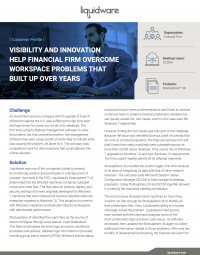Liquidware Solutions and Innovation Help Trading Firm Overcome Workspace Problems That Built up Over Years
An investment services company with thousands of branch offices throughout the U.S. was suffering through slow boot and login times for some, but not all, of its desktops. The firm tried using its desktop management software to solve the problem, but that uncovered another: the management software they were using couldn’t provide data to indicate what was causing the problem, let alone fix it. The company was compelled to look for other solutions that could address this critical situation.
Liquidware was one of the companies invited to present its monitoring solution and participate in a 45-day proof of concept. Very early in the POC, Liquidware’s StratusphereTM UX determined that the affected machines contained outdated scripts and other files. The files were for printers, registry and security settings that were originally developed for Windows 7 machines that were retained but became obsolete when the enterprise migrated to Windows 10. This situation is common with Windows migrations and typically impacts workspaces with deteriorated performance.
Stratusphere UX identified the culprit files as the source of slow boot/logins through a key feature: Login Breakdown. This feature delineates the boot/login process’s constituent processes and policies. Detailed login information is provided, including group policy objects (GPOs), Windows license status, scripts and much more so administrators don’t have to conduct numerous tests to isolate individual problematic variables but can quickly isolate the root cause, which in this case were the Windows 7-related files.
However, finding the root cause was only part of the challenge. Because the issue was identified during a proof of concept that ran only on a limited population, the financial services firm still didn’t know how many machines were vulnerable across its more than 20,000 active desktops. They used a mix of Windows 7 upgrades to Windows 10, and new Windows 10 deployments. The firm couldn’t readily identify all its affected machines.
Stratusphere UX provided the solution again, this time because of its ease of integrating its data with that of other vendor’s solutions. The company used Microsoft System Center Configuration Manager (SCCM) to help manage its desktop population. Using Stratusphere UX and SCCM together allowed it to identify the machines needing remediation.
The boot process stressed some machines so much they couldn’t run fast enough for Stratusphere UX to identify all their problematic files. Here, Liquidware’s ability to innovate ultimately solved the problem. Liquidware’s field service team worked with the client and analyzed some of the most problematic login and boot code issues. Its software developers then updated the Stratusphere UX agent to collect additional information related to those problems. After only two months of development and testing, the financial services firm deployed the updated agent. Soon it was running diagnostics and applying fixes across its entire population, including the worst-performing machines which had multiple hidden problems as well as login-specific issues.
Stratusphere UX revealed that approximately 40 percent of the financial services firms’ desktops had old files or other issues that were slowing user boot and logins. The files were removed from all affected machines and boot/login times immediately improved.
Login times have improved by an average of 30 percent company-wide because of the information and troubleshooting Stratusphere UX provides. The improvements have been significantly higher for the old Windows 7 machines and at locations that have low bandwidth (Stratusphere UX can restore network connections and provides visibility to network connectivity, data usage, and latencies associated with processes that communicate over the network).
The company now uses Stratusphere UX to continually monitor all 20,000 desktops for performance and user experience issues. Faster logins benefit the tens of thousands of employees that use the firm’s systems each day and issues that do develop are resolved much more quickly than they could be in the past. Financial markets will always have volatility, but now this financial services firm always has visibility and consistently excellent performance across its desktops.

